Renaissance
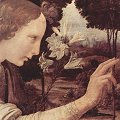 1400 - 1530.
Centered in Italy, the
1400 - 1530.
Centered in Italy, the  Renaissance was a period of
great creative and intellectual activity, during which artists broke
away from the restrictions of medieval art. Throughout the 15th
century, artists studied the natural world in order to perfect their
understanding of such subjects as anatomy and perspective. Among the
many great artists of this period were Giotto, Masaccio, Sandro
Botticelli, Domenico Ghirlandaio, and Piero della Francesca. The Early Renaissance was succeeded by the
mature High Renaissance period, which began circa 1500. The High
Renaissance was the culmination of the artistic developments of the
Early Renaissance, and one of the great explosions of creative genius
in history of arts. It is notable for three of the greatest artists in
history: Michelangelo, Raphael
and Leonardo da Vinci. Also active at that time
were such masters as Giorgione, Titian and
Giovanni Bellini. In northern Europe there was a Northern
Renaissance period with artists such as Albrecht Durer
and Pieter Bruegel.
Renaissance was a period of
great creative and intellectual activity, during which artists broke
away from the restrictions of medieval art. Throughout the 15th
century, artists studied the natural world in order to perfect their
understanding of such subjects as anatomy and perspective. Among the
many great artists of this period were Giotto, Masaccio, Sandro
Botticelli, Domenico Ghirlandaio, and Piero della Francesca. The Early Renaissance was succeeded by the
mature High Renaissance period, which began circa 1500. The High
Renaissance was the culmination of the artistic developments of the
Early Renaissance, and one of the great explosions of creative genius
in history of arts. It is notable for three of the greatest artists in
history: Michelangelo, Raphael
and Leonardo da Vinci. Also active at that time
were such masters as Giorgione, Titian and
Giovanni Bellini. In northern Europe there was a Northern
Renaissance period with artists such as Albrecht Durer
and Pieter Bruegel.
-
Italy, the cradle of Renaissance:
Rome,
Vatican,
Florence,
Pisa,
Siena,
and more. (595 high-quality photos)
Artists and Articles
Piero della Francesca
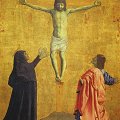 Piero della Francesca, an Italian artist, one of
the greatest artists of the Early Renaissance. His
painting art is characterized by its serene humanism and its use of
geometric forms, particularly in relation to perspective. He wrote
books on solid geometry and on perspective, and his works reflect
these interests. Francesca's solid, rounded figures are derived from
Masaccio, while from Domenico he absorbed a predilection for delicate
colors and scenes bathed in cool, clear daylight. To these influences
he added an innate sense of order and clarity. He
conceived of the human figure as a volume in space, and the outlines
of his subjects have the grace, abstraction, and precision of
geometric drawings. Almost all of Piero's works are religious in
nature - primarily altarpieces and church frescoes in which he
presents scenes of astonishing beauty, with silent, stately
figures fixed in clear, crystalline space. There are always
large areas of white or near-white in his works, the skies are big,
light and sunny. The monumental quality of his figures, the
perspectival construction of the pictorial space and the spiritual
calm of his compositions led, throughout Italy, to the final
surmounting of the Gothic style and prepared the way for the artistic
achievements of High Renaissance in Italy.
Piero della Francesca, an Italian artist, one of
the greatest artists of the Early Renaissance. His
painting art is characterized by its serene humanism and its use of
geometric forms, particularly in relation to perspective. He wrote
books on solid geometry and on perspective, and his works reflect
these interests. Francesca's solid, rounded figures are derived from
Masaccio, while from Domenico he absorbed a predilection for delicate
colors and scenes bathed in cool, clear daylight. To these influences
he added an innate sense of order and clarity. He
conceived of the human figure as a volume in space, and the outlines
of his subjects have the grace, abstraction, and precision of
geometric drawings. Almost all of Piero's works are religious in
nature - primarily altarpieces and church frescoes in which he
presents scenes of astonishing beauty, with silent, stately
figures fixed in clear, crystalline space. There are always
large areas of white or near-white in his works, the skies are big,
light and sunny. The monumental quality of his figures, the
perspectival construction of the pictorial space and the spiritual
calm of his compositions led, throughout Italy, to the final
surmounting of the Gothic style and prepared the way for the artistic
achievements of High Renaissance in Italy.
 Diptych Portrait of Battista Sforza (1472)
© Piero della Francesca
Diptych Portrait of Battista Sforza (1472)
© Piero della Francesca
 Polyptych of Misericordia, St. Sebastian and St. John the Baptist (1464)
© Piero della Francesca
Polyptych of Misericordia, St. Sebastian and St. John the Baptist (1464)
© Piero della Francesca
 The Queen of Sheba in Adoration of the Wood and the Meeting of Solomon and the Queen of Sheba (Detail 5) (1466)
© Piero della Francesca
The Queen of Sheba in Adoration of the Wood and the Meeting of Solomon and the Queen of Sheba (Detail 5) (1466)
© Piero della Francesca
- Piero della Francesca Art, $19
 (95 pictures)
(95 pictures)
- Piero della Francesca. Evaluation of art.
- Piero della Francesca. Life and art.
Leonardo da Vinci
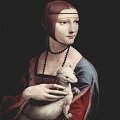 Leonardo da Vinci, Italian High Renaissance painter, sculptor, architect, engineer, scientist and
inventor. Leonardo da Vinci was an amazing painter. His paintings
contained incredible detail, which made them seem almost real. This
detail included things like various shadow effects and textures which
gave the works lifelike appearances. Although Leonardo produced a
relatively small number of paintings, many of which remained
unfinished, he was nevertheless an extraordinarily innovative
and influential artist. As a scientist Leonardo towered above all his
contemporaries - Leonardo actually anticipated many discoveries of
modern times. In anatomy he studied the circulation of the blood and
the action of the eye. He made discoveries in meteorology and geology,
learned the effect of the moon on the tides, foreshadowed modern
conceptions of continent formation, and surmised the nature of fossil
shells. He was among the originators of the science of hydraulics. He
invented a large number of ingenious machines, many potentially
useful.
Leonardo da Vinci, Italian High Renaissance painter, sculptor, architect, engineer, scientist and
inventor. Leonardo da Vinci was an amazing painter. His paintings
contained incredible detail, which made them seem almost real. This
detail included things like various shadow effects and textures which
gave the works lifelike appearances. Although Leonardo produced a
relatively small number of paintings, many of which remained
unfinished, he was nevertheless an extraordinarily innovative
and influential artist. As a scientist Leonardo towered above all his
contemporaries - Leonardo actually anticipated many discoveries of
modern times. In anatomy he studied the circulation of the blood and
the action of the eye. He made discoveries in meteorology and geology,
learned the effect of the moon on the tides, foreshadowed modern
conceptions of continent formation, and surmised the nature of fossil
shells. He was among the originators of the science of hydraulics. He
invented a large number of ingenious machines, many potentially
useful.
 Mona Lisa (La Gioconda) (1505)
© Leonardo da Vinci
Mona Lisa (La Gioconda) (1505)
© Leonardo da Vinci
 Portrait of Cecilia Gallerani (1490)
© Leonardo da Vinci
Portrait of Cecilia Gallerani (1490)
© Leonardo da Vinci
- Leonardo da Vinci Art, $25
 (80 pictures)
(80 pictures)
- Leonardo da Vinci. Life and biography.
- Leonardo da Vinci. Evaluation of art.
Michelangelo
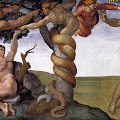 Michelangelo was considered the greatest living
artist in his lifetime, and ever since then he has been held to be one
of the greatest artists of all times. A number of his works in
painting, sculpture, and architecture rank among the most famous in
existence. Michelangelo is one of the greatest artists of all time, a
man whose name has become synonymous with the word "masterpiece". As
an artist he was unmatched, the creator of works of sublime beauty
that express the full breadth of the human condition. Giorgio Vasari
proposed that Michelangelo was the pinnacle of all artistic
achievement since the beginning of the Renaissance, a viewpoint that
continued to be influential in art history for centuries. In his
lifetime he was also often called Il Divino (the divine one),
an appropriate name given his intense spirituality. One of the
qualities most admired by his contemporaries was his sense of
awe-inspiring grandeur, and it was the attempts of subsequent artists
to imitate Michelangelo's impassioned and highly personal style that
resulted in the next major movement in Western art after the High
Renaissance, Mannerism.
Michelangelo was considered the greatest living
artist in his lifetime, and ever since then he has been held to be one
of the greatest artists of all times. A number of his works in
painting, sculpture, and architecture rank among the most famous in
existence. Michelangelo is one of the greatest artists of all time, a
man whose name has become synonymous with the word "masterpiece". As
an artist he was unmatched, the creator of works of sublime beauty
that express the full breadth of the human condition. Giorgio Vasari
proposed that Michelangelo was the pinnacle of all artistic
achievement since the beginning of the Renaissance, a viewpoint that
continued to be influential in art history for centuries. In his
lifetime he was also often called Il Divino (the divine one),
an appropriate name given his intense spirituality. One of the
qualities most admired by his contemporaries was his sense of
awe-inspiring grandeur, and it was the attempts of subsequent artists
to imitate Michelangelo's impassioned and highly personal style that
resulted in the next major movement in Western art after the High
Renaissance, Mannerism.
 Sistine Chapel, Ancestors of Christ 2 (Detail) (1511)
© Michelangelo
Sistine Chapel, Ancestors of Christ 2 (Detail) (1511)
© Michelangelo
 Sistine Chapel, Lunettes, Rehoboam and Abijah (Detail) (1512)
© Michelangelo
Sistine Chapel, Lunettes, Rehoboam and Abijah (Detail) (1512)
© Michelangelo
 Sistine Chapel, Pendentives, David and Goliath (Detail) (1509)
© Michelangelo
Sistine Chapel, Pendentives, David and Goliath (Detail) (1509)
© Michelangelo
- Michelangelo Art, $29
 (180 pictures)
(180 pictures)
- Michelangelo. Art, life and biography.
- Michelangelo. Michelangelo's David.
- Michelangelo. Michelangelo's Pieta.
- Michelangelo. Sistine Chapel. High Renaissance Masterpiece.
- Michelangelo. Sistine Chapel. Book of Genesis.
- Michelangelo. Sistine Chapel. The Ignudi.
- Michelangelo. Sistine Chapel. Seven Prophets.
- Michelangelo. Sistine Chapel. Five Sibyls.
- Michelangelo. Sistine Chapel. Lunettes.
- Michelangelo. Sistine Chapel. Pendentives.
- Michelangelo. Sistine Chapel. The Ancestors of Christ.
- Michelangelo. Sistine Chapel. The Last Judgement.
Raphael
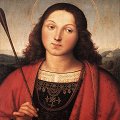 Raphael or Raffaello Sanzio is an Italian High
Renaissance painter and architect of the Florentine
school, celebrated for the perfection and grace of his
art, his mastery of dynamic composition and movement. Raphael, like
Michelangelo and Da Vinci, is one of the most famous artists of Italy's
High Renaissance and one of the greatest influences in the history of
Western art. Raphael is best known for his Madonnas and for his large
figure compositions in the Vatican in Rome. By his artistic means
Raphael has achieved constant movement throughout his
paintings, without letting it become restless or unbalanced. Raphael
was seen to have accomplished what the older generation had striven so
hard to achieve: the perfect and harmonious composition of freely
moving figures.
Raphael or Raffaello Sanzio is an Italian High
Renaissance painter and architect of the Florentine
school, celebrated for the perfection and grace of his
art, his mastery of dynamic composition and movement. Raphael, like
Michelangelo and Da Vinci, is one of the most famous artists of Italy's
High Renaissance and one of the greatest influences in the history of
Western art. Raphael is best known for his Madonnas and for his large
figure compositions in the Vatican in Rome. By his artistic means
Raphael has achieved constant movement throughout his
paintings, without letting it become restless or unbalanced. Raphael
was seen to have accomplished what the older generation had striven so
hard to achieve: the perfect and harmonious composition of freely
moving figures.
 St. Sebastian (1502)
© Raphael
St. Sebastian (1502)
© Raphael
 The Granduca Madonna (1504)
© Raphael
The Granduca Madonna (1504)
© Raphael
 Portrait of Maddalena Doni (1506)
© Raphael
Portrait of Maddalena Doni (1506)
© Raphael
- Raphael Art, $25
 (125 pictures)
(125 pictures)
- Raphael. Art, life and biography.
- Raphael. Frescoes in rooms of Vatican.
- Raphael. Religious paintings.
- Raphael. Madonnas.
- Raphael. Portraits.
Titian
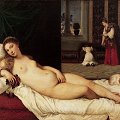 Tiziano Vecellio, better known as Titian, the
leader of the 16th-century Venetian school of the Italian High/Late
Renaissance, and the greatest Venetian artist of the
16th century, the shaper of the Venetian coloristic and painterly
tradition. Titian contributed to all of the major areas of Renaissance
art, painting altarpieces, portraits, mythologies, and pastoral
landscapes. He is one of the key figures in the history of Western
art. His work, which permanently affected the course of European
painting, provided an alternative, of equal power and attractiveness,
to the linear and sculptural Florentine tradition championed by
Michelangelo and Raphael; this
alternative, eagerly taken up by Rubens, Diego Velazquez, Rembrandt, Eugene Delacroix, and the Impressionists, is
still vital today. In its own right Titian's work often attains the
very highest reach of human achievement in the visual arts.
Tiziano Vecellio, better known as Titian, the
leader of the 16th-century Venetian school of the Italian High/Late
Renaissance, and the greatest Venetian artist of the
16th century, the shaper of the Venetian coloristic and painterly
tradition. Titian contributed to all of the major areas of Renaissance
art, painting altarpieces, portraits, mythologies, and pastoral
landscapes. He is one of the key figures in the history of Western
art. His work, which permanently affected the course of European
painting, provided an alternative, of equal power and attractiveness,
to the linear and sculptural Florentine tradition championed by
Michelangelo and Raphael; this
alternative, eagerly taken up by Rubens, Diego Velazquez, Rembrandt, Eugene Delacroix, and the Impressionists, is
still vital today. In its own right Titian's work often attains the
very highest reach of human achievement in the visual arts.
 Venus of Urbino (Detail) (1538)
© Titian
Venus of Urbino (Detail) (1538)
© Titian
 Madonna in Glory with Christ and Sts Francis and Alvise with the Donor (Detail) (1520)
© Titian
Madonna in Glory with Christ and Sts Francis and Alvise with the Donor (Detail) (1520)
© Titian
 Man with Gloves (1524)
© Titian
Man with Gloves (1524)
© Titian
- Titian Art, $29
 (175 pictures)
(175 pictures)
- Titian. Art and life.
- Titian. Early art works by Titian.
- Titian. Late art works by Titian.
Albrecht Durer
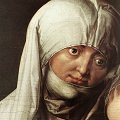 Albrecht Durer, a German painter and printmaker.
Durer is generally regarded as the greatest Northern Renaissance artist. His famous paintings have been the subject of
extensive analysis and interpretation. His watercolours
mark him as one of the first European landscape artists, while his
ambitious woodcuts revolutionized the potential of that medium.
Durer's introduction of classical motifs into Northern art, through
his knowledge of Italian artists and German humanists, have secured
his reputation as one of the most important figures of the Northern
Renaissance. This is reinforced by his theoretical works which involve
principles of mathematics, perspective and ideal proportions. The
quality and wide range of his works and themes, both in terms
of content and formal aspects, are astonishing. Though his paintings
were normally produced as the result of a commission - his two main
areas of focus were portrait painting and the creation of altar pieces
and devotional pictures - Durer enriched them with unusual pictorial
solutions and adapted them to new functions.
After his death, Durer remained one of the most highly regarded of
artists for centuries, representing the process of transition from the
late Middle Ages to the Renaissance in Germany.
Albrecht Durer, a German painter and printmaker.
Durer is generally regarded as the greatest Northern Renaissance artist. His famous paintings have been the subject of
extensive analysis and interpretation. His watercolours
mark him as one of the first European landscape artists, while his
ambitious woodcuts revolutionized the potential of that medium.
Durer's introduction of classical motifs into Northern art, through
his knowledge of Italian artists and German humanists, have secured
his reputation as one of the most important figures of the Northern
Renaissance. This is reinforced by his theoretical works which involve
principles of mathematics, perspective and ideal proportions. The
quality and wide range of his works and themes, both in terms
of content and formal aspects, are astonishing. Though his paintings
were normally produced as the result of a commission - his two main
areas of focus were portrait painting and the creation of altar pieces
and devotional pictures - Durer enriched them with unusual pictorial
solutions and adapted them to new functions.
After his death, Durer remained one of the most highly regarded of
artists for centuries, representing the process of transition from the
late Middle Ages to the Renaissance in Germany.
 Portrait of Barbara Durer (1490)
© Albrecht Durer
Portrait of Barbara Durer (1490)
© Albrecht Durer
 St. Anne with the Virgin and Child (1519)
© Albrecht Durer
St. Anne with the Virgin and Child (1519)
© Albrecht Durer
- Albrecht Durer Art, $25
 (120 pictures)
(120 pictures)
- Albrecht Durer. Altar paintings.
- Albrecht Durer. Portraits.
- Albrecht Durer. Life and work.
More
Movements
 Art Encyclopedia A world history of art in articles.
Art Encyclopedia A world history of art in articles.
Renaissance
Baroque
Romanticism
Impressionism
Postimpressionism
Modernism
Postmodernism
Art
 Art Wallpapers Art image collections for your desktop.
Art Wallpapers Art image collections for your desktop.
